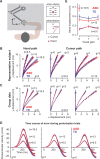Behavioural and neural basis of anomalous motor learning in children with autism
- PMID: 25609685
- PMCID: PMC4339776
- DOI: 10.1093/brain/awu394
Behavioural and neural basis of anomalous motor learning in children with autism
Abstract
Autism spectrum disorder is a developmental disorder characterized by deficits in social and communication skills and repetitive and stereotyped interests and behaviours. Although not part of the diagnostic criteria, individuals with autism experience a host of motor impairments, potentially due to abnormalities in how they learn motor control throughout development. Here, we used behavioural techniques to quantify motor learning in autism spectrum disorder, and structural brain imaging to investigate the neural basis of that learning in the cerebellum. Twenty children with autism spectrum disorder and 20 typically developing control subjects, aged 8-12, made reaching movements while holding the handle of a robotic manipulandum. In random trials the reach was perturbed, resulting in errors that were sensed through vision and proprioception. The brain learned from these errors and altered the motor commands on the subsequent reach. We measured learning from error as a function of the sensory modality of that error, and found that children with autism spectrum disorder outperformed typically developing children when learning from errors that were sensed through proprioception, but underperformed typically developing children when learning from errors that were sensed through vision. Previous work had shown that this learning depends on the integrity of a region in the anterior cerebellum. Here we found that the anterior cerebellum, extending into lobule VI, and parts of lobule VIII were smaller than normal in children with autism spectrum disorder, with a volume that was predicted by the pattern of learning from visual and proprioceptive errors. We suggest that the abnormal patterns of motor learning in children with autism spectrum disorder, showing an increased sensitivity to proprioceptive error and a decreased sensitivity to visual error, may be associated with abnormalities in the cerebellum.
Keywords: autism; cerebellum; error sensitivity; motor learning; proprioception; reaching.
© The Author (2015). Published by Oxford University Press on behalf of the Guarantors of Brain. All rights reserved. For Permissions, please email: journals.permissions@oup.com.
Figures




References
-
- Adrian ED. Afferent areas in the cerebellum connected with the limbs. Brain. 1942;4:289–315.
-
- Allen G, Courchesne E. Differential effects of developmental cerebellar abnormality on cognitive and motor functions in the cerebellum: an fMRI study of autism. Am J Psychiatry. 2003;160:262–73. - PubMed
-
- Bailey A, Luthert P, Dean A, Harding B, Janota I, Montgomery M, et al. A clinicopathological study of autism. Brain. 1998;121(Pt 5):889–905. - PubMed
Publication types
MeSH terms
Grants and funding
LinkOut - more resources
Full Text Sources
Other Literature Sources
Medical

